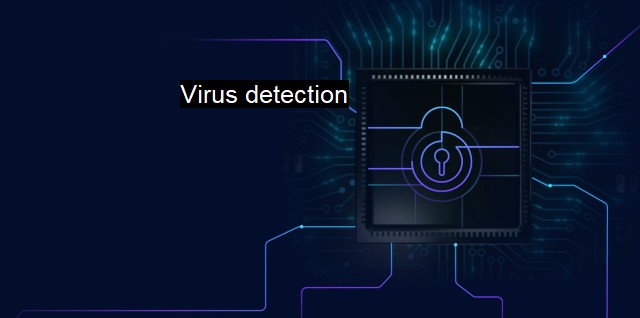What is Virus detection?
The Crucial Role of Virus Detection in Cybersecurity and Antivirus Software: Understanding the Threat of Intrusive Malware and How to Protect Your Electronic Devices and Networks"
Virus detection in the context of cybersecurity and antivirus refers to the process by which protective software identifies and addresses threats to computer systems and networks. These threats can take various forms such as viruses, worms, trojans, ransomware, spyware, adware, and other forms of malware designed to exploit, damage or cause harm to a computer or electronic device.The type of software used for this activity is known as Antivirus software and its primary function is to guard a computer system and its networks against potential threats or intrusions. These antivirus programs are designed to scan, detect and remove viruses and other malicious activities.
A major component of an antivirus solution's effective performance is its virus detection ability. Early versions of these programs solely relied on identifying virus signatures; a "fingerprint" unique to each virus. Whenever a new virus was discovered, antivirus companies needed to analyse the virus, create a signature, then update their software databases to enable detection of this new threat. This detection method was effective but slow; it meant the user was always one step behind in the ongoing race with cybercriminals.
Over time, advances in technology and antivirus programs led to the development of heuristic-based detection. This method detects malware by studying their behaviours rather than relying on specific predefined virus signatures. Heuristics allow antivirus software greater flexibility and the capacity to detect new, as-yet-unknown viruses and variants of existing viruses.
A significant aspect of virus detection is determining the risks posed by suspicious software activities. Real-time protection or on-access scanning are among the mechanisms employed by antivirus software for this task. These mechanisms operate in the system background, scanning files when they're accessed or downloaded, and blocking or isolating anything which behaves like a known virus or exhibits suspicious behaviour.
Despite the advancements made in virus detection technology, cyber criminals persistently try to stay one step ahead. They use techniques such as polymorphism and obfuscation so that their malicious programs constantly evolve and adapt to bypass established detection and defence mechanisms. Consequently, cybersecurity experts and antivirus manufacturers continually innovate, developing advanced detection methods like behavioural analysis and machine learning.
Behavioural analysis goes beyond scanning for just known virus signatures or suspicious behaviours. It monitors how a program or file behaves once executed in a system; if the behaviour mimics malware characteristics (such as changes in registry settings, data encrypted or hidden), the antivirus flags it as a threat.
Machine learning, increasingly popular in various sectors including cybersecurity, employs automated analytical algorithms to learn patterns from vast amounts of data, improving its performance through constant learning. In the realm of virus detection, multiple antivirus software manufacturers are integrating machine learning algorithms to help in identification and mitigation of frequently changing or never before seen (zero-day) threats.
Virus detection is a critical aspect of cybersecurity operations. It helps in identifying and countering threats, ultimately safeguarding the information and integrity of computer systems and electronic devices. The techniques used in virus detection have evolved considerably from signature-based to more advanced heuristic, behavioural, and machine learning methods. the fight against cyber threats is an ongoing battle and developers constantly have to update and improve their antivirus software to combat new and evolving threats.

Virus detection FAQs
What is virus detection?
Virus detection is a process of identifying the presence of malicious software in a computer system. This process involves scanning the computer system for malicious programs and files that can harm the system or steal sensitive information.What are the methods used for virus detection?
There are several methods used for virus detection, such as signature-based detection, heuristic-based detection, behavioral analysis, and sandboxing. Signature-based detection identifies viruses by matching the file signatures with a database of known virus signatures. Heuristic-based detection is used to identify unknown viruses by analyzing their behavior. Behavioral analysis detects viruses based on their behavior and actions on a system. Sandboxing is a technique that isolates the potentially harmful program and checks its behavior in a controlled environment.Why do I need virus detection software?
You need virus detection software to protect your computer system from cyber threats. Cyber threats, such as viruses, malware, and spyware, can harm your system, steal sensitive information, and cause significant financial losses. Virus detection software helps to detect and remove these threats before they can cause any harm to your system.How can I choose the best virus detection software?
Choosing the best virus detection software depends on various factors such as the level of protection, ease of use, compatibility with your system, and the price. Look for a software that offers real-time protection, regular updates, and scanning options. Check the reviews of the software and its performance on independent testing labs. It is also essential to choose a software that is compatible with your system and offers good customer support.| | A | | | B | | | C | | | D | | | E | | | F | | | G | | | H | | | I | | | J | | | K | | | L | | | M | |
| | N | | | O | | | P | | | Q | | | R | | | S | | | T | | | U | | | V | | | W | | | X | | | Y | | | Z | |
| | 1 | | | 2 | | | 3 | | | 4 | | | 7 | | | 8 | | |||||||